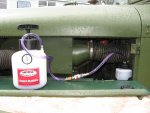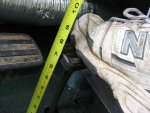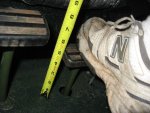UPFINN
Member
- 231
- 4
- 18
- Location
- Ishpeming Michigan
This week I finished rebuilding my wheel cylinders and installing a remote reservoir. No more leaks! 
I bled over half to 3/4 of a gallon of fresh dot5 through the system at 15 psi. I am sure there is no air left in it with that much bled, and I also bled about 16 oz from the air pack. Now for some reason my pedal seems to travel down further before the brakes grab and resistance begins.
I set the shoes at the top and bottom adjust points both to .015, as done by many. Feeler gauge was quite stiff to get in at the ends of the shoes but a lot of slop in the middle of shoes. My shoes looked to have at least 3/16 of thickness before rivets. I had no drag.
I am measuring about 1/2 to 3/4 inch of free play at the top of the pedal travel, and there is about 1/2 inch of threads visible on master push rod. The pedal has to go down at least 3 inches before any braking occurs. Very hard braking puts it almost even with the gas pedal. Is this acceptable?
My hubs are also getting hot, but not the drums. Last year when I repacked bearings I set the inner nut to 50ft lbs, backed off 1/4 a turn, and set outer to 130. The little cork piece was in the key way. Hubs were cold when driving right after service, but after 700 miles, gear oil washed grease from bearings. Either the seal wasn't preloaded enough or the keyway cork was too old and small.
For the last service, I repacked bearings and set inner nut to 50 ft lbs, backed off 1/8 turn, and set outer nut to 130 again. Filled key way with cork and rtv. Drove it 15 miles yesterday evening with an outside temp of 55F, average speed of 45mph, and the hubs were very warm. Not uncomfortable to touch though, just concerning. Will everything loosen up with use, or will I "burn up" the bearings?
Here is my reservoir location and bleeder setup. The fluid level can be seen from outside of the truck through the crack in the panel corner.

Magnetic bleeder/siphon bottle.

Pedal with no foot.

Pedal free play.

Full pedal travel before braking.


I bled over half to 3/4 of a gallon of fresh dot5 through the system at 15 psi. I am sure there is no air left in it with that much bled, and I also bled about 16 oz from the air pack. Now for some reason my pedal seems to travel down further before the brakes grab and resistance begins.
I set the shoes at the top and bottom adjust points both to .015, as done by many. Feeler gauge was quite stiff to get in at the ends of the shoes but a lot of slop in the middle of shoes. My shoes looked to have at least 3/16 of thickness before rivets. I had no drag.
I am measuring about 1/2 to 3/4 inch of free play at the top of the pedal travel, and there is about 1/2 inch of threads visible on master push rod. The pedal has to go down at least 3 inches before any braking occurs. Very hard braking puts it almost even with the gas pedal. Is this acceptable?
My hubs are also getting hot, but not the drums. Last year when I repacked bearings I set the inner nut to 50ft lbs, backed off 1/4 a turn, and set outer to 130. The little cork piece was in the key way. Hubs were cold when driving right after service, but after 700 miles, gear oil washed grease from bearings. Either the seal wasn't preloaded enough or the keyway cork was too old and small.
For the last service, I repacked bearings and set inner nut to 50 ft lbs, backed off 1/8 turn, and set outer nut to 130 again. Filled key way with cork and rtv. Drove it 15 miles yesterday evening with an outside temp of 55F, average speed of 45mph, and the hubs were very warm. Not uncomfortable to touch though, just concerning. Will everything loosen up with use, or will I "burn up" the bearings?
Here is my reservoir location and bleeder setup. The fluid level can be seen from outside of the truck through the crack in the panel corner.

Magnetic bleeder/siphon bottle.

Pedal with no foot.

Pedal free play.

Full pedal travel before braking.



